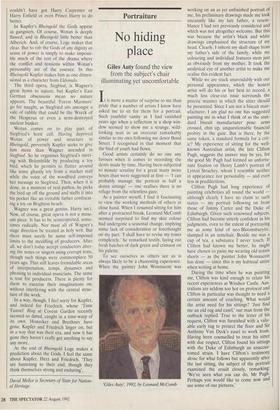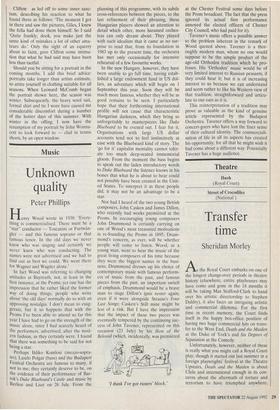Portraiture
No hiding place
Giles Auty found the view from the subject's chair illuminating yet uncomfortable It is more a matter of surprise to me than pride that a number of artists I know have asked me to sit for them for a portrait. Such youthful vanity as I had vanished years ago when a reflection in a shop win- dow seemed to show me a strange, wild- looking man in an overcoat remarkably similar to my own following me down Bond Street. I recognised in that moment that the bird of youth had flown.
Good artists certainly do no one any favours when it comes to recording the dents made by time. Having been subjected to minute scrutiny for a great many more hours than were suggested at first — 'I can probably manage the portrait in half a dozen sittings' — one realises there is no refuge from the relentless gaze.
As a painter myself, I find it fascinating to view the working methods of others at close hand. When I resumed sitting for him after a protracted break, Leonard McComb seemed surprised to find my skin colour had undergone a seasonal change, implying some lack of consideration or forethought on my part. 'I shall have to revise my tones completely,' he remarked testily, laying out fresh batches of dark green and crimson on his palette.
To see ourselves as others see us is always likely to be a chastening experience. When the painter John Wonnacott was 'Giles Auty, 1992, by Leonard McComb working on an as yet unfinished portrait of me, his preliminary drawings made me look uncannily like my late father, a resem- blance I had not previously considered and which was not altogether welcome. But this was because the artist's black and white drawings emphasised the structure of my head. Clearly, I inherit my skull shape from my father's side of the family, while my colouring and individual features stem just as obviously from my mother. It took the analytical eye of another artist to make me realise this evident fact.
While we are stuck unavoidably with our personal appearance, which the honest artist will do his or her best to record, a much less clear-cut issue surrounds the precise manner in which the sitter should be presented. Since I am not a biscuit man- ufacturer, I am glad no one has suggested painting me in what I think of as the stan- dard biscuit manufacturer pose: arms crossed, chin up, unquestionable financial probity in the gaze. But is there, by the same token, a standard formula for a crit- ic? My experience of sitting for the well- known Australian artist, the late Clifton Pugh, suggests the answer may be yes, for the good Mr Pugh had formed an unfortu- nate fixation on Henry Lamb's portrait of Lytton Strachey, whom I resemble neither in appearance nor personality — and even less in predilections. Clifton Pugh had long experience of painting celebrities all round the world although clearly I have no claim to such status — my portrait following on from those of Jimmy Carter and the Duke of Edinburgh. Given such renowned subjects, Clifton had become utterly confident in his judgments, even to the extent of portraying me as some kind of neo-Bloomsburyite, slumped in an armchair. Beside me was a cup of tea, a substance I never touch. If Clifton had known me better, he might have chosen to paint me wearing old tennis shorts — as the painter John Wonnacott has done — since this is my habitual attire when writing at home.
During the time when he was painting me, Clifton was kind enough to relate his recent experiences at Windsor Castle. Aus- tralians are seldom too hot on protocol and Clifton in particular was thought to need a certain amount of coaching. What would the artist need for his sittings? 'Just find me an old rug and easel,' our man from the outback replied. True to the letter of his request, Clifton was furnished with a valu- able early rug to protect the floor and Sir Anthony Van Dyck's easel to work from. Having been counselled to treat his sitter with due respect, Clifton found his sittings with the Duke of Edinburgh an unaccus- tomed strain. I have Clifton's testimony alone for what follows but apparently after the last sitting, the subject of the portrait examined the result closely, remarking: 'We've seen what you can do, Mr Pugh. Perhaps you would like to come now and see some of our pictures.'
Clifton as led off to some inner sanc- tum, desci ibing his reaction to what he found there as follows: 'The moment I got in there and saw the pictures, Giles, I knew the fella had done them himself. So I said `Quite frankly, dook, you make just the same kind of mistakes a lot of other ama- teurs do.' Only the sight of an equerry about to faint, gave Clifton some intima- tion that what he had said may have been less than tactful.
Should you be sitting for a portrait in the coming months, I add this brief advice: portraits take longer than artists estimate, so attire yourself in clothing suitable for all seasons. When Leonard McComb began the portrait shown here, the season was winter. Subsequently, the heavy wool suit, formal shirt and tie I wore have caused me considerable discomfort during a number of the hotter days of this summer. With winter in the offing, I now have the resumption of my portrait by John Wonna- cott to look forward to — clad in tennis shorts, by an open window.











































 Previous page
Previous page